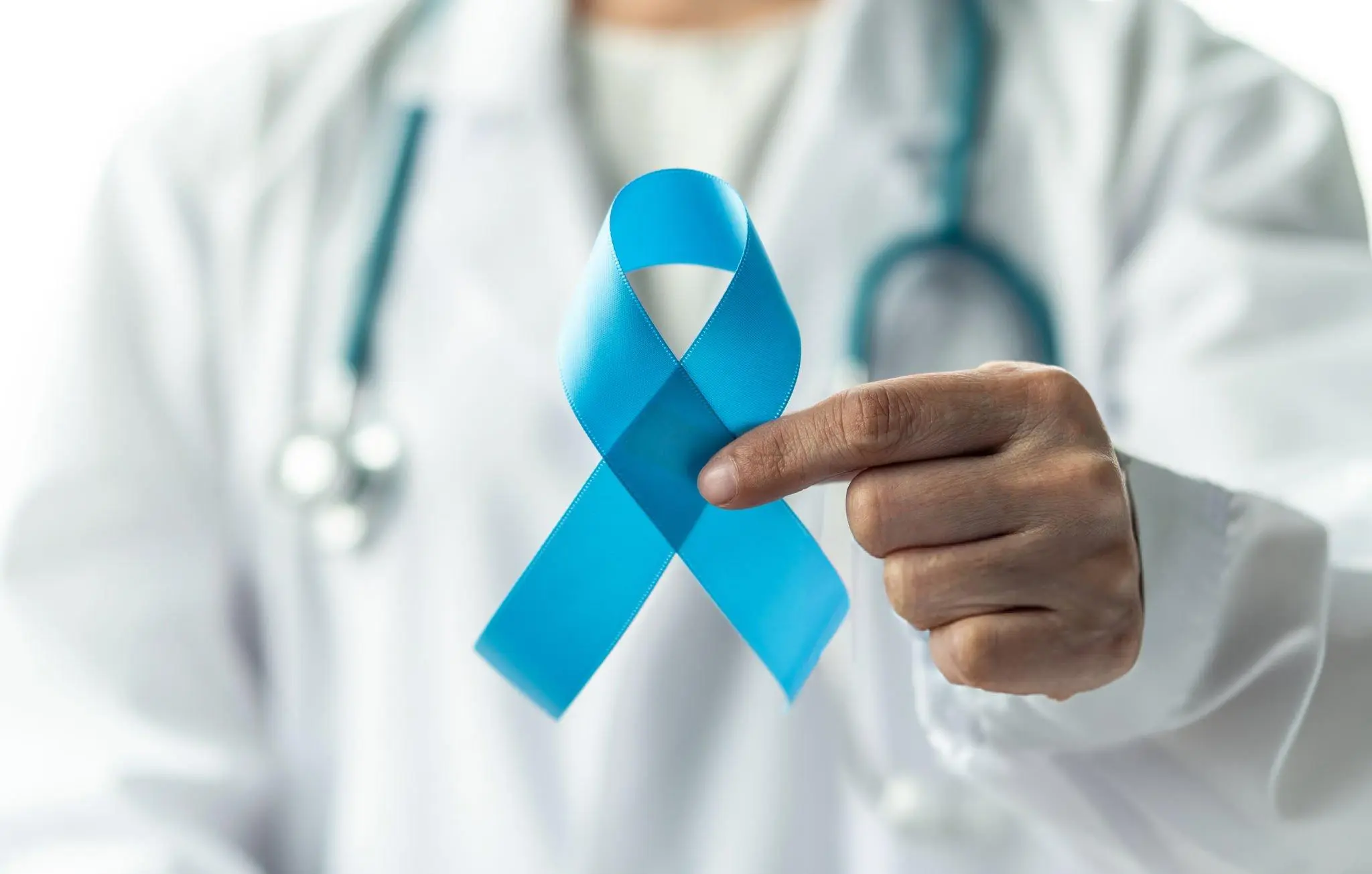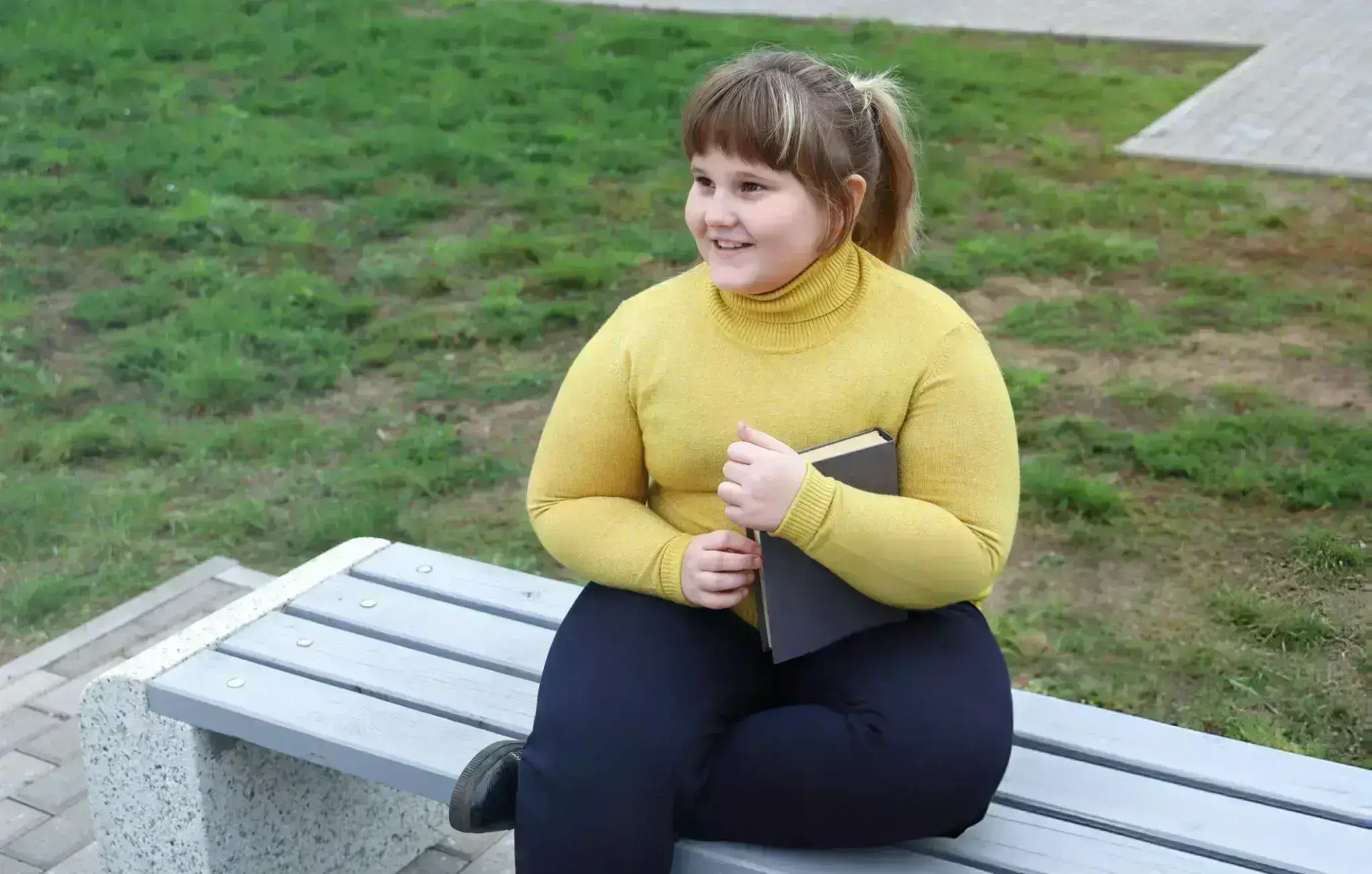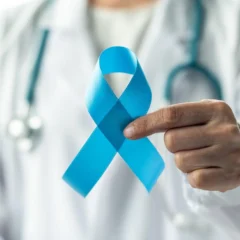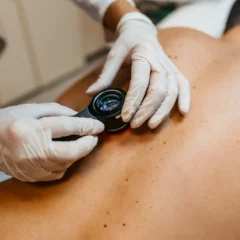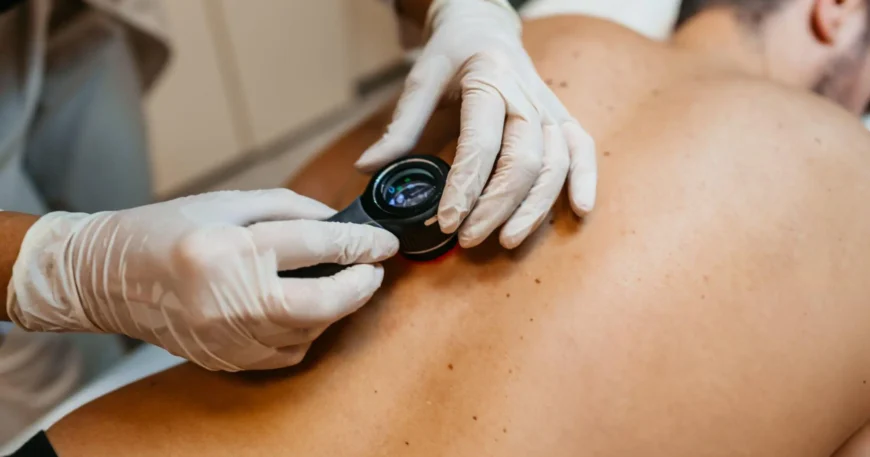
Skin Cancer Screening: Why Regular Checks Can Save Your Life
Picture this: you’re enjoying another beautiful summer day in NSW when you notice a mole on your arm that looks a bit different. It could be darker than usual, or the edges seem uneven. Your first thought? “I will keep an eye on it.” But here’s the thing by the time changes are obvious to you, it might already be too late.
Australia has one of the highest rates of skin cancer in the world. Every year, more than 15,000 Australians are diagnosed with melanoma, and unfortunately, many of these cases could have been caught earlier. The good news? Regular skin cancer screening can literally save your life.
Worried about your skin? Book a skin cancer check with Huntlee Healthcare today.
What Is Skin Cancer Screening?
Skin cancer screening is a simple check where a trained healthcare professional examines your skin from head to toe. They look for any suspicious spots, moles, or changes that might indicate the early stages of skin cancer.
The process is straightforward. You’ll undress so the doctor can see all parts of the body, including areas you might not check yourself – like your back, scalp, or between your toes. Using a special magnifying tool called a dermatoscope, they examine each spot carefully.
Most checks take about 10-15 minutes. That’s less time than it takes to grab coffee at your local cafe, but it could make all the difference to your health.
Why Australia’s Sun Makes Screening Essential
Living in Australia means being exposed to some of the world’s most intense UV radiation. Our beautiful climate comes with a price – the sun’s rays are particularly strong here due to our location and the hole in the ozone layer above Antarctica.
Even on cloudy days, up to 80% of UV rays can penetrate through clouds. Sand, water, and concrete reflect these rays at you, increasing your exposure. If you’re someone who loves the beach, plays outdoor sports, or works outside, your risk of skin cancer increases significantly.
The numbers don’t lie. Two in three Australians will be diagnosed with some form of skin cancer by age 70. That’s not meant to scare you – it’s meant to show you why checking your skin regularly matters so much.
Understanding Your Risk Level
Not everyone has the same risk of skin cancer, but most Australians face higher odds than people in other countries. Your risk increases if you:
Have fair skin, light hair, or light-colored eyes: These features mean you have less melanin, which normally helps protect against UV damage.
Spend long hours in the sun: Outdoor workers like builders, farmers, and landscapers face particularly high exposure. Even weekend warriors who love cricket, golf, or cycling are at increased risk.
Have a family history: If your parents, siblings, or close relatives have had skin cancer, your chances are higher. Genetics play a real role here.
Are over 50 years old: Age brings accumulated sun damage. Most skin cancers develop after decades of UV exposure, which is why risk climbs as we get older.
Have many moles or freckles: More moles mean more opportunities for changes to occur. People with 50 or more moles need to be especially careful.
Even if you don’t tick these boxes, regular screening is still smart. Skin cancer can affect anyone, regardless of skin tone or lifestyle.
The Three Main Types You Need to Know
Basal Cell Carcinoma: This is the most common form of skin cancer in Australia. It grows slowly and rarely spreads to other parts of the body. You might notice a small, shiny bump or a flat, scaly patch that doesn’t heal properly.
Squamous Cell Carcinoma: The second most common type. It can spread if left untreated, but early detection leads to excellent outcomes. Look for thick, rough, scaly patches or open sores that don’t heal.
Melanoma: The most dangerous type, but also the least common. Melanoma can spread quickly to other organs, making early detection crucial. It often appears as a new mole or a change in an existing mole.
The keyword here is “change.” Any spot on your skin that looks different from your other moles, or any existing mole that changes size, shape, or colour, deserves professional attention.
What Happens During a Professional Screen
Your first skin cancer screen might feel a bit awkward you will need to undress so the doctor can examine your whole body. But remember, this is routine for healthcare professionals, and they’ve seen it all before.
The doctor starts by looking at your skin with the naked eye, checking each area systematically. They’ll use a dermatoscope to get a closer look at any spots that catch their attention. This tool magnifies the skin and shows patterns invisible to the naked eye.
If they find something concerning, they might take a photo for your records or recommend a biopsy. Don’t panic if this happens most biopsies come back clear. It’s better to check and be safe than to ignore something that could be serious.
The whole appointment usually takes 10-20 minutes, depending on how many spots need closer examination. You’ll get results immediately for most observations, though any biopsy results take a few days.
Regular screening makes all the difference. Schedule your skin cancer check at Huntlee Healthcare and get peace of mind knowing your skin is in safe hands.
How Often Should You Get Checked?
The frequency depends on your risk level. Most adults should have their skin checked annually, but some people need more frequent screening.
Annual checks: work well for people with low to moderate risk. This includes most Australians over 40 who spend a reasonable time in the sun.
Every six months: might be better if you have fair skin, many moles, or a family history of skin cancer. People who’ve had skin cancer before also fall into this category.
Every three months: is recommended for very high-risk individuals, such as people who have had melanoma or those with many atypical moles.
Your doctor can help determine the right schedule for your situation. They’ll consider your personal risk factors, skin type, and medical history.
The Role of Self-Checks
Professional screening is crucial, but checking your own skin between appointments is equally important. Skin cancer can develop quickly, and you’re the person most likely to notice changes.
Once a month, examine your skin in good light using a full length mirror. Don’t forget areas like your scalp (use a hand mirror or ask someone to help), the soles of your feet, between your toes, and your back.
Look for the ABCDE signs:
- Asymmetry: One half doesn’t match the other
- Border: Edges are irregular, blurred, or jagged
- Colour: The colour isn’t uniform or has changed
- Diameter: Larger than 6mm (about the size of a pencil eraser)
- Evolving: Any change in size, shape, colour, or symptoms
Take photos of any spots you’re concerned about. This helps you track changes over time and gives your doctor useful information.
Medicare and Costs
Here’s some good news: Medicare covers skin cancer screening for people at increased risk. This includes anyone over 50, people with fair skin, those with a family history of skin cancer, or anyone who’s had skin cancer before.
Even if Medicare doesn’t fully cover your screening, the cost is relatively small compared to treating advanced skin cancer. Most clinics charge between $80-150 for a comprehensive skin check.
Some private health insurance policies also cover preventive skin screening. Check with your insurer to see what’s included in your coverage.
Skin cancer checks are quick, simple, and often covered by Medicare. Call Huntlee Healthcare or book online today to arrange your appointment.
What If Something Is Found?
Finding something suspicious doesn’t automatically mean cancer. Many spots that look concerning turn out to be harmless. But if a biopsy does show cancer, early detection gives you the best possible outcome.
Most skin cancers caught early can be removed with a simple procedure in your doctor’s office. The cure rate for skin cancers detected early is over 95%.
Even melanoma, the most serious type, has excellent survival rates when caught in its early stages. The five-year survival rate for early-stage melanoma is nearly 100%.
This is why regular screening matters so much. The difference between catching skin cancer early and late can literally be the difference between life and death.
Making Prevention Part of Your Routine
While screening is crucial, prevention is even better. Australia’s intense sun means you need to be smart about UV protection.
Use sunscreen with at least SPF 30+ every day, not just when you’re planning to be outside. UV rays penetrate windows and reflect off surfaces, so you’re getting exposure even during your daily commute.
Wear protective clothing when possible. Long sleeves, wide-brimmed hats, and sunglasses make a real difference. Many clothing brands now make lightweight, UV-protective gear that’s comfortable even in hot weather.
Seek shade during peak UV hours (10 am to 3 pm). If your shadow is shorter than you are, the UV radiation is intense.
Remember, there’s no such thing as a “healthy tan.” Any change in skin colour means DNA damage has occurred. Embrace your natural skin tone and protect it properly.
Special Considerations for Different Ages
30s and 40s: This is when many people first start thinking seriously about skin health. If you’ve been a sun lover, now’s the time to start annual checks and better sun protection habits.
50s and beyond: Risk increases significantly with age. Annual screening becomes even more important, and you might need more frequent checks if you have multiple risk factors.
Teens and 20s: While skin cancer is less common in younger people, those with many moles, very fair skin, or family history should still consider professional screening. Building good habits early pays off later.
Parents should also check their children’s skin regularly and teach them about sun safety. Childhood sunburns significantly increase adult cancer risk.
Finding the Right Healthcare Provider
Look for a doctor experienced in skin cancer screening. Many GPs provide excellent screening services, especially in areas like NSW where skin cancer rates are high.
Some practices specialise in skin cancer detection and use advanced imaging technology. While not always necessary, these tools can be helpful for people at very high risk.
Ask about the doctor’s experience with skin cancer screening. How many checks do they perform each year? Do they use dermoscopy? Are they comfortable performing biopsies if needed?
The most important thing is finding someone you trust and feel comfortable with. You’ll likely be seeing them annually for years to come.
Technology and Advances in Screening
Modern screening technology has come a long way. Digital dermoscopy allows doctors to take high-quality images of suspicious spots and track changes over time.
Some clinics now use artificial intelligence to help analyse spots, though this technology supplements rather than replaces professional judgment.
Full-body photography is another tool that helps track changes across your entire body. These photos create a baseline that makes it easier to spot new or changing moles at future appointments.
While technology helps, the human element remains crucial. An experienced eye and careful clinical examination are still the gold standard for skin cancer screening.
Taking Action Today
The statistics are clear: regular skin cancer screening saves lives. In Australia, where UV exposure is intense and skin cancer rates are among the world’s highest, screening isn’t optional it’s essential. Most skin cancers are completely curable when caught early. The five minute check that feels slightly awkward could prevent months of treatment, surgery, or worse.
Don’t wait until you notice something concerning. By then, valuable time may have been lost. Make screening part of your routine health care, just like dental checkups or eye exams. Protect your health with a simple step book your skin cancer screening at Huntlee Healthcare. Early detection saves lives. Call us now or book online to secure your appointment.
Your future self will thank you for taking this step today. In a country where two out of three people will develop skin cancer, regular screening isn’t just smart it’s potentially lifesaving.
FAQS
What is skin cancer screening?
Skin cancer screening is a medical check where a GP or trained doctor examines your skin from head to toe. They use tools like a dermatoscope to look for unusual spots or moles that may indicate early signs of cancer.
Why is skin cancer screening important in Australia?
Australia has one of the highest rates of skin cancer in the world due to strong UV radiation. Regular screening helps detect cancer early, when treatment is most effective and survival rates are highest.
How often should I get a skin cancer screening?
Most adults should have a professional skin check once a year. People with fair skin, many moles, family history of skin cancer, or past skin cancer should book checks every 6 to 12 months.
Who is most at risk for skin cancer?
Those with fair skin, light eyes or hair, outdoor workers, people with many moles, individuals over 50, and anyone with a family or personal history of skin cancer are at higher risk.
What happens during a skin cancer check?
A doctor will examine your whole body, including areas you may not notice yourself. They look for changes in size, shape, or colour of moles and may recommend a biopsy if something looks suspicious.
How much does a skin cancer screening cost in Australia?
Skin cancer checks typically cost between $80–150. Medicare covers screenings for people at increased risk, and some private health insurers also provide rebates.
Does Medicare cover skin cancer screening?
Yes, Medicare covers skin cancer checks for high-risk patients, including people over 50, those with fair skin, family history, or a previous diagnosis of skin cancer.
Can a GP perform a skin cancer screening?
Yes, many GPs in Australia are trained to provide skin cancer checks. They can perform the examination, take photos, and organise a biopsy or referral to a specialist if required.
What are the early warning signs of skin cancer?
Watch for the ABCDE signs: Asymmetry, irregular Borders, uneven Colour, Diameter larger than 6mm, and Evolving changes in moles or spots. Any new or changing spot should be checked.
How do I book a skin cancer check in NSW?
You can book a skin cancer check directly with your GP or at a dedicated skin clinic. Huntlee Healthcare in NSW offers professional screenings. Call us or book online today.

